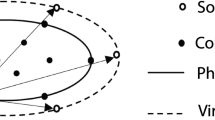Abstract
In this paper, we are concerned with the nonoverlapping domain decomposition method with Lagrange multiplier for three-dimensional second-order elliptic problems with no zeroth-order term. It is known that the methods result in a singular subproblem on each internal (floating) subdomain. To handle the singularity, we propose a regularization technique which transforms the corresponding singular problems into approximate positive definite problems. For the regularized method, one can build the interface equation of the multiplier directly. We first derive an optimal error estimate of the regularized approximation, and then develop a cheap preconditioned iterative method for solving the interface equation. For the new method, the cost of computation will not be increased comparing the case without any floating subdomain. The effectiveness of the new method will be confirmed by both theoretical analyzes and numerical experiments.
Similar content being viewed by others
References
Y. Achdou, Yu. Kuznetnov and O. Pironneau, Substructuring preconditioners for the Q 1 mortar element method, Numer. Math. 71 (1995) 419–449.
Y. Achdou, Y. Maday and O. Widlund, Iterative substructuring preconditioners for mortar element methods in two dimensions, SIAM J. Numer. Anal. 36 (1999) 551–580.
F. Belgacem, The mortar finite element method with Lagrange multipliers, Numer. Math. 84 (1999) 173–197.
F. Belgacem and Y. Maday, The mortar element method for three dimensional finite elements, Math. Modelling Numer. Anal. 31 (1997) 289–302.
C. Bernardi, Y. Maday and A. Patera, A new nonconforming approach to domain decomposition: The mortar element method, in: Nonlinear Partial Differential Equations and Their Applications, College de France Seminar, Vol. XI (Paris, 1989–1991) (Longman Sci. Tech., Harlow, 1994) pp. 13–51.
J. Bramble, J. Pasciak and A. Schatz, The construction of preconditioners for elliptic problems by substructuring, IV, Math. Comp. 53 (1989) 1–24.
T.F. Chan and Jun Zou, A convergence theory of multilevel additive Schwarz methods on unstructured meshes, Numer. Algorithms 13 (1996) 365–398.
Q. Dinh, R. Glowinski and J. Periaux, Solving elliptic problems by domain decomposition methods with applications, in: Elliptic Problem Solver II (Academic Press, New York, 1982).
M. Dorr, On the discretization of interdomain coupling in elliptic boundary-value problems, in: Domain Decomposition Methods, ed. T.F. Chan (SIAM, Philadelphia, 1989) pp. 17–37.
Q. Du, Optimization based nonoverlapping domain decomposition algorithms and their convergence, SIAM J. Numer. Anal. 39 (2001) 1056–1077.
C. Farhat, J. Mandel and F. Roux, Optimal convergence properties of the FETI domain decomposition method, Comput. Methods Appl. Mech. Engrg. 115 (1994) 367–388.
C. Farhat, M. Lesoinne and K. Pierson, A scalable dual–primal domain decomposition method, Numer. Linear Algebra Appl. 7 (2000) 687–714.
W. Hackbusch and B. Khoromskij, A sparse ℋ-matrix arithmetic. II: Application to multi-dimensional problems, Computing 64 (2000) 21–47.
Q. Hu, Study of domain decomposition methods with non-matching grids, Ph.D. thesis, Institute of Mathematics, Chinese Academy of Science, Beijing (1998).
Q. Hu, A new kind of preconditioner for interface equations of mortar multipliers on subspaces, in: Recent Progress in Computational and Applied PDEs, eds. T. Chan et al. (Kluwer Academic Publishers, 2002) pp. 203–214.
Q. Hu and G. Liang, Acceleration of the non-symmetrized two-level iteration, Appl. Numer. Math. 41 (2002) 305–323.
Q. Hu and G. Liang, A general framework to construct interface preconditioners, Chinese J. Num. Math. Appl. 21 (1999) 83–95 (Published in New York).
Q. Hu, G. Liang and J. Lui, The construction of preconditioner for domain decomposition methods with polynomial Lagrangian multipliers, J. Comp. Math. 19 (2001) 213–224.
Q. Hu and J. Zou, A non-overlapping domain decomposition method for Maxwell's equations in three dimensions, SIAM J. Numer. Anal. 41 (2003) 1682–1708.
J. Huang and J. Zou, A mortar element method for elliptic problems with discontinuous coefficients, IMA J. Numer. Anal. 22 (2002) 549–576.
A. Klawonn, O. Widlund and M. Dryja, Dual–primal FETI methods for three-dimensional elliptic problems with heterogeneous coefficients, SIAM J. Numer. Anal. 40 (2002) 159–179.
C. Kim, R. Lazarov, J. Pasciak and P. Vassilevski, Multiplier spaces for the mortar finite element method in three dimensions, SIAM J. Numer. Anal. 39 (2001) 517–538.
Y. Kuznetsov, Efficient iterative solvers for elliptic finite element problems on non-matching grids, Russian J. Numer. Anal. Math. Modeling 10(3) (1995) 187–211.
C. Lacour, Iterative substructuring preconditioners for the mortar finite element method, in: Ninth International Conference of Domain Decomposition Methods, eds. P. Bjorstad, M. Espedal and D. Keyes (1997).
G. Liang and J. He, The non-conforming domain decomposition method for elliptic problems with Lagrangian multipliers, Chinese J. Num. Math. Appl. 15(1) (1993) 8–19.
G. Liang and P. Liang, Non-conforming domain decomposition with the hybrid finite element method, Math. Numer. Sinica 11(3) (1989) 323–332.
J. Mandel and R. Tezaur, Convergence of a substructuring methods with Lagrangian multipliers, Numer. Math. 73 (1996) 473–487.
B. Smith, P. Bjorstad and W. Gropp, Domain Decomposition: Parallel Multilevel Methods for Elliptic Partial Differential Equations (Cambridge University Press, 1996).
P. Tallec, Domain decomposition methods in computational mechanics, Comput. Mech. Adv. 2 (1994) 1321.
P. Tallec, T. Sassi and M. Vidrascu, Three-dimensional domain decomposition methods with nonmatching grids and unstructured coarse solvers, Contemp. Math. 180 (1994) 61–74.
B. Wohlmuth, A mortar finite element method using dual spaces for the Lagrange multiplier, SIAM J. Numer. Anal. 38 (2000) 989–1012.
J. Xu, Iterative methods by space decomposition and subspace correction, SIAM Review 34 (1992) 581–613.
J. Xu and J. Zou, Some non-overlapping domain decomposition methods, SIAM Review 40 (1998) 857–914.
Author information
Authors and Affiliations
Corresponding author
Additional information
Communicated by Achui Zhou
The work is supported by Natural Science Foundation of China G10371129.
Rights and permissions
About this article
Cite this article
Hu, Q. A regularized domain decomposition method with Lagrange multiplier. Adv Comput Math 26, 367–401 (2007). https://doi.org/10.1007/s10444-004-4094-4
Received:
Accepted:
Published:
Issue Date:
DOI: https://doi.org/10.1007/s10444-004-4094-4
Keywords
- domain decomposition
- nonmatching grids
- mortar element
- Lagrange multipliers
- regularization
- interface equation
- preconditioner
- condition number




